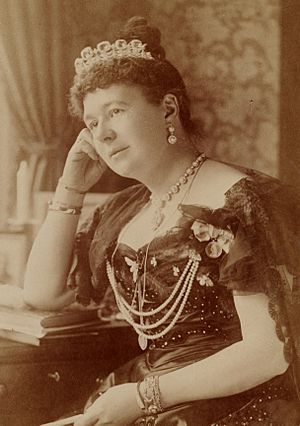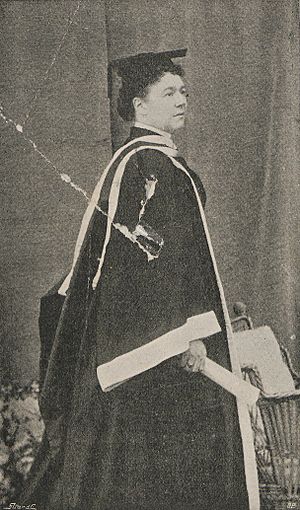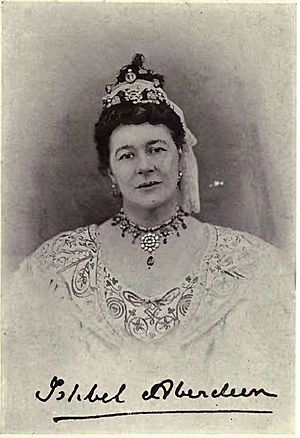Ishbel Hamilton-Gordon, Marchioness of Aberdeen and Temair facts for kids
Quick facts for kids
The Most Honourable
The Marchioness of Aberdeen and Temair
|
|
|---|---|

Lady Aberdeen by W.J. Byrne & Co., 1899
|
|
| Born |
Isabel Maria Marjoribanks
15 March 1857 London, England
|
| Died | 18 April 1939 (aged 82) Rubislaw, Aberdeen, Scotland
|
| Other names | Ishbel Hamilton-Gordon Isabel Aberdeen |
| Occupation | Author, philanthropist |
| Spouse(s) | John Hamilton-Gordon, 1st Marquess of Aberdeen and Temair |
| Children | George Gordon, 2nd Marquess of Aberdeen and Temair Marjorie Sinclair, Baroness Pentland Dudley Gordon, 3rd Marquess of Aberdeen and Temair Lord Archibald Gordon |
| Parent(s) | Dudley Marjoribanks, 1st Baron Tweedmouth Isabella Weir-Hogg |
Ishbel Maria Hamilton-Gordon (born Isabel Maria Marjoribanks, 15 March 1857 – 18 April 1939) was an amazing British woman. She was an author, someone who helped others (a philanthropist), and a strong supporter of women's rights.
She was married to John Hamilton-Gordon, 1st Marquess of Aberdeen and Temair. Because of his important jobs, she became the wife of the Governor General of Canada from 1893 to 1898. She also served as the wife of the Lord Lieutenant of Ireland from 1906 to 1915.
Contents
Growing Up and Early Life
Ishbel was born in London, England, on March 15, 1857. She was the third daughter of the 1st Baron Tweedmouth and Isabella Weir-Hogg. She got a great education at home. She studied English, French, math, history, and geography. Her teacher even thought she should go to college!
However, her father believed that university was not for women. So, Ishbel continued her learning at home. She met many important politicians at her parents' parties. This helped her get ready for a life involved in politics. From a young age, Ishbel believed in helping others and improving society.
On November 7, 1877, she married John Campbell Hamilton-Gordon. He was the 7th Earl of Aberdeen. They had four children: George (born 1879), Marjorie (1880), Dudley (1883), and Archibald (1884). Ishbel was a very supportive wife. She not only took care of her family but also helped her husband with all his work.
Helping Others in England and Scotland
John, Ishbel's husband, was a member of the House of Lords. This is part of the British Parliament. Ishbel helped him by hosting social events. She was very smart and determined. Soon, she started her own work as an activist.
The family split their time between London and their home in Aberdeenshire, Scotland. Their Scottish home was called Haddo House. Here, Ishbel began her work to help people. She started a Household Club. This club offered classes for servants to learn singing, carving, reading, and other skills. The Aberdeens often joined their servants' evening events. People in London even rumored that they sometimes ate meals together! They also helped pay for a local school and hospital. Helping with healthcare was something Ishbel cared about her whole life.
Ishbel's influence grew beyond her home. She created the Onwards and Upward Association. This group gave servant girls postal courses on many topics. These included geography, literature, and home economics. This program grew from Aberdeenshire to help thousands of servants.
In 1883, she became the first president of the Ladies’ Union of Aberdeen. This group focused on the well-being of young women in cities. An Emigration Committee helped suitable women move to other countries, especially Canada. Ishbel also led the Women's Liberal Federation. This group worked to get women the right to vote.
Making a Difference in Canada
In 1893, Ishbel's husband became the Governor General of Canada. This was a very important job, and he stayed in this role until 1898. The Aberdeens had visited Canada many times before. In 1890, they even bought land in British Columbia. During that trip, they saw how hard life was for pioneers on the prairies.
Because of this, Ishbel started the Aberdeen Association for Distribution of Good Literature to Settlers in the West. This group sent books and magazines to settlers.
Ishbel was very dedicated to her role as the Governor General's wife (Viceregal consort of Canada). She hosted many popular events, like winter festivals and costume balls. She was also more involved in politics than previous Governor Generals' wives. She traveled a lot, went to events, and gathered information for her husband. She often gave him advice. Newspapers even said that she seemed to be the one in charge!
In 1893, Ishbel became the first president of the International Council of Women. This group works for women's rights around the world. She then created the National Council of Women of Canada. She traveled across Canada to set up local groups. One person she worked with was Adelaide Hoodless, who later started the Women's Institute.
Ishbel was also the first sponsor of the Women's Art Association of Canada, started in 1892. Another one of her projects was the May Court Club. This group allowed wealthy young women to do charity work. A very important group she helped create was the Victorian Order of Nurses. This organization aimed to give women better training and pay. This way, they could help people in rural areas and those who were struggling. Ishbel and her supporters had to work hard to get this group approved. They finally got a special royal approval in 1898. That same year, the Aberdeens went back to England.
Helping in Ireland
Ishbel's husband belonged to the Liberal Party. When they came back to power in 1906, he was named the Lord Lieutenant of Ireland for the second time. He had been Lord Lieutenant for about six months in 1886.
Ishbel always cared about the Irish people. She helped her husband succeed during his time in office. She promoted Irish crafts and became the head of the Association of Irish Industries.
Their second time in Ireland lasted from 1906 to 1915. This time, Ishbel focused on healthcare and people's well-being. She worked with groups like the Women's National Health Association of Ireland. These groups worked to treat and prevent tuberculosis and improve children's health. There's even a street named after her, Lady Ishbel Avenue, in south Belfast.
In 1911, she was the first president of the Housing and Town Planning Association of Ireland. She pushed for better housing and public spaces to help with poverty. Lady Aberdeen's Cottages in Mullingar are named after her. Even though she was popular during her first time in Ireland, things were different when she returned.
By 1906, many Irish people wanted more independence from Britain. Because Ishbel was British, some people were against her. Also, she was very determined to do things her way. This sometimes meant she didn't fully understand the Irish point of view.
Later Years
Ishbel and her husband retired to their home in Scotland. But they kept working on social causes. They wrote a book together called We Twa, which came out in 1925. It was very popular. After her death, her Canadian diary, The Canadian Journal of Lady Aberdeen, 1893–1898, was published in 1960.
In 1931, Ishbel presented a petition to the General Assembly of the Church of Scotland. This petition, signed by 336 women, asked for women to be allowed to become ministers and leaders in the church. The church only agreed to let women become deacons at that time. It wasn't until 1968 that women could become elders or ministers in the Church of Scotland. Ishbel continued to be the president of the International Council of Women until 1936. She passed away from a heart attack on April 18, 1939, in Scotland.
Achievements and Recognition

Ishbel received many honors for her work. In 1894, she was given the Freedom of Limerick, Ireland. In 1928, she received the Freedom of Edinburgh, Scotland. In 1931, she was given a special honor called Dame Grand Cross in the Order of the British Empire (GBE).
The Lady Aberdeen Bridge in Gatineau, Quebec, Canada, was named after her. This happened after she fell through the ice near the bridge and was rescued by local people.
Ishbel is also known for bringing the Golden Retriever dog breed to Canada. Her father, Sir Dudley Coutts Marjoribanks, was the person who first developed this breed.
Several places in Canada are named after Ishbel and her husband. Aberdeen Avenue in Hamilton, Ontario, and Aberdeen Avenue in Toronto are named for them. Aberdeen Street in Kingston, Ontario, near Queen's University, is also named after the couple. Because she was so popular in Canada, the Canadian government gave her 18 fancy tea sets! This gift was for her own hard work and impact, not just because of her husband's position.
She was the first woman to become an honorary member of the British Medical Association.
The Ontario Heritage Trust placed a special plaque for Lady Aberdeen at Rideau Hall in Ottawa. It says she was "widely respected for her organizational skills and strong commitment to public service." It also notes that she helped form the National Council of Women of Canada. Lady Aberdeen was also named a National Historic Person in Canada.
Robert Gordon University in Scotland has a building named after her on its Garthdee campus.
Images for kids



